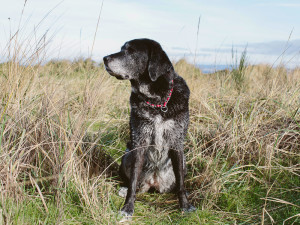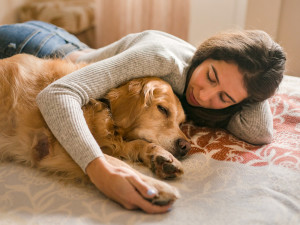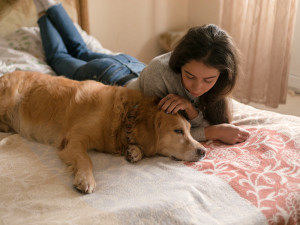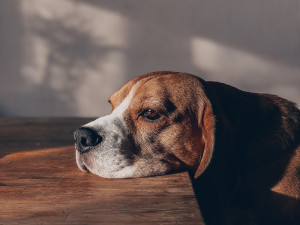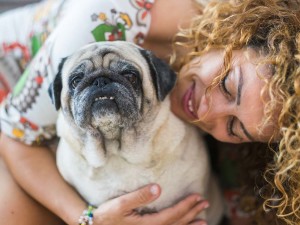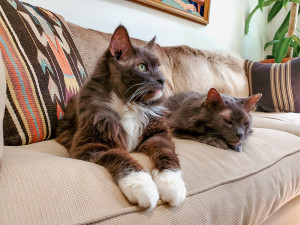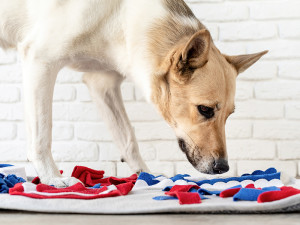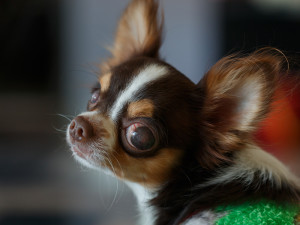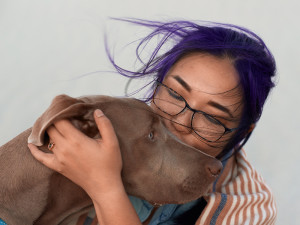Ashes to Ashes, Pet to Plant
The founders of Pleia, a startup that practices pet composting, on this method of honoring pets after death.
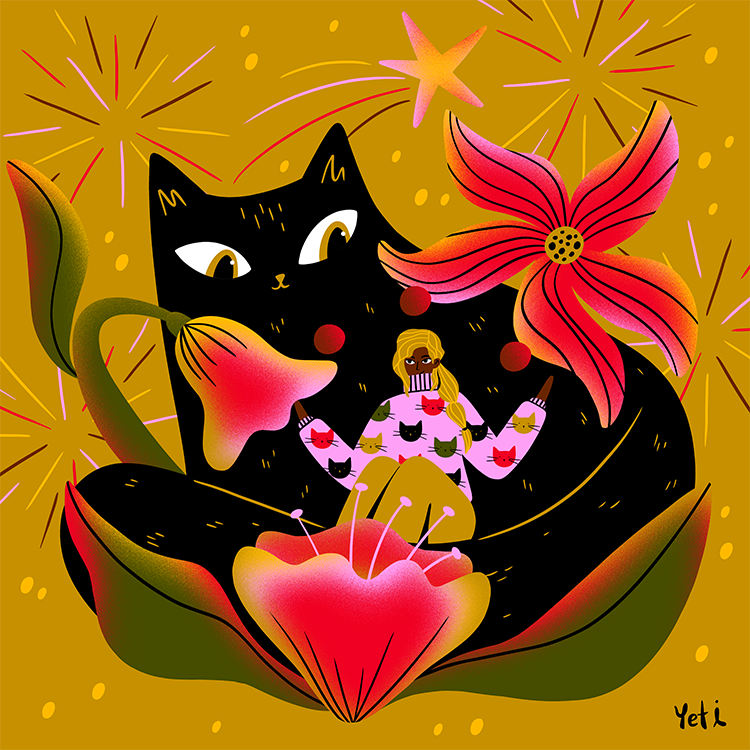
Share Article
In Judith Viorst’s picture book The Tenth Good Thing About Barneyopens in new tab (1987) a family grapples with the death of their cat, Barney. The parents encourage their son to share 10 good things about his cat as they bury Barney under a tree. The boy says how Barney was brave, smart, funny, clean, cuddly, and handsome — but he can only think of only nine things. As the boy tries to think of a 10th thing, his father asks him to help plant seeds. Seeds may not look like much, but as the father says: “In the ground everything changes.” He explains that Barney, too, will “change until he’s part of the ground in the garden” and that Barney will help flowers, trees, and grass grow. “You know,” says the father, “that’s a pretty nice job for a cat.” That is the 10th good thing about Barney.
Burying a cat — or any pet — in a backyard is not a groundbreaking idea (though you do have to break ground to do it). Trust me, I’ve been burying my dead pets since the early ’90s: countless goldfish (1992-1999), Kiki (Gloster canary, 1997), Finy (zebra finch, 1997), Wanda (betta fish, 2007), Gwen (Cairn Terrier, 2013). Sometimes, though, it’s not always that easy. Some boards of health prohibit backyard burial of petsopens in new tab, and often there are strict rules about how close to a water source you can bury an animal or how deep of a grave you must dig. There are environmental concernsopens in new tab about burying a pet who was put to sleep with euthanasia solution.
And there is also the matter of moving — I’ve left animals graves behind in the yards of all the places I’ve ever lived, but some people think you should have to discloseopens in new tab if animals are buried on a property before selling it, and there is a massive Reddit threadopens in new tab about people being freaked out after discovering pet skeletons while gardening in their yards. But now, there might be a way to let your pet more intentionally become part of your garden, transforming them into a new life in the form of a tree or flower or plant: composting.
Pleiaopens in new tab, a start-up based outside of Medellín, Colombia, founded by Melissa Naranjo Hoyos and Daniel Correa Jaramillo in 2018, has devised a streamlined approach to the 10th good thing about Barney. Naranjo Hoyos and Correa Jaramillo met in veterinary school, where they were taught that there are only two methods of disposal for the body of a dead pet: cremation or burial. In their last year of school, the two collaborated on a project investigating the environmental impact of these limited options.
With cremation, 96 percent of the body gets released into the atmosphere as pollution; with burial, there are the aforementioned safety concerns, as well as how much space is required. Naranjo Hoyos and Correa Jaramillo researched another option that would be environmentally safe (no atmospheric emissions), energy efficient (no use of additional fuel or water), and biosecure (no risk of pathogens). They came up with a process of creating organic compost from pet bodies, inspired by the natural way a body decomposes after death.

“We see the body as organic matter that can create a new life,” Correa Jaramillo says in a Zoom interview. “You don’t have to see death as only darkness.”
The pair’s thesis won the prize for excellence from their university, and that made them think that it shouldn’t just be “stored in a library” but taken into the real world. After graduating, Naranjo Hoyos and Correa Jaramillo began Pleia.
Colombian pet owners are numerous — seven out of 10 families in the country have a petopens in new tab, about the same as in the United States — but backyard pet burial is illegal in the country. The first year Pleia started, Naranjo Hoyos and Correa Jaramillo composted 100 pets total, beginning with pets of their families and friends; now they compost up to 600 pets per month from all over the country. Once a pet has been composted, owners can choose to either have the soil added to Pleia’s garden — like one might choose to bury their animal in a cemetery — or have the soil returned to them in a pot with a plant of their choosing, a plant specifically grown in the composted soil. This process costs anywhere from $50 to $242, depending on if you have the soil returned to you or not, how many plants you choose, and what kinds. This is more money than it costs to bury your pet in your backyard (free but, in Colombia, illegal), but also less than the cost of burying in a pet cemetery (usually beginning around $400) or cremation (around $250 for your pet to be individually cremated).
Not only has composting become a successful business model, but it also helps dispel the concentration of euthanasia solution better than simply burying, and, looking at studies on human burials, often the varnish from coffins can pollute the soil and chemicals like formaldehyde can contaminate groundwater. With composting, none of those factors are issues, and it does not require the same amount of fuel that cremation does, nor does it take up the same amount of long-term space that goes with burial.
Twenty-seven-year-old Alejandra Calderón Buenahora, who used to live in Medellín but is now based in Mexico City, learned about Pleia from her veterinarian when her dog, Lupita, first got sick. Calderón Buenahora said she was taken by the idea of composting. “Just thinking that I could have her close to me in another way of life, made me think that it was the best way to remember all the love that she gave me,” she shares with me in an email. She wasn’t interested in cremation because there isn’t much to do with a box of ashes after the fact besides stick them on a shelf, but she loved the idea of having her beloved dog transformed into a plant.
After Lupita died, staff from Pleia laid the dog’s body in their “garden of life” facility. The garden is located on the side of mountain, with sweeping views of the rolling green hills of the Colombian countryside. The centerpiece of the garden is an open-air greenhouse — a roof hoisted up by bamboo posts, no sides — beneath which lie the individual small containers of dirt and wood chips in which the animals are composted, lined up neatly in rows like the orphanage beds in Madeline. A sweeping grassy expanse surrounds the composting area on all sides — lush with trees and shrubs and dotted with memorial plaques for those animals whose owners chose to have their composted remains stay in the garden.
Composting plant matter, such as garden cuttings or kitchen scraps, is relatively simple, but animal matter requires more technical knowledge and a precise process. “If you don’t control this process very well, the solution can become a new problem,” Calderón Buenahora says. (Calderón Buenahora actually tried to DIY compost her deceased pet canary by burying it in the soil with Lupita’s plant, and the plant almost died. “We had to do a whole process of disinfection of parasites, fungi, and a lot of things that came out of the body of that little animal,” Calderón Buenahora writes. “Now imagine if we did it with a dog, I think it would be a disaster!”) Pleia staff monitor the temperature, humidity, and pH levels in the soil as the body composts, and they add a special “biotechnology product,” a mix of various microorganisms, to increase the speed of decomposition.
Lupita’s body was transformed into soil over the course of about three and a half months. (Correa Jaramillo said the composting process itself takes 45 to 60 days, and then the growing of the plant in the soil made from the compost can take another 15 to 30 days.) While Lupita was being composted, staff at Pleia sent updates to Calderón Buenahora every 10 days — no gory photos — with messages about where the body was in the composting process, explaining how the body was transforming. Pleia’s clients are also welcome to come visit the garden itself, to be “part of the transformation,” as Correa Jaramillo put it. He says about half of their clients do visit the garden, often bringing messages, photos, and pet toys.
Once the composting process was complete, Calderón Buenahora was able to choose the plant she wanted for Lupita. In the end she picked two — one for herself, and one for her family, since Lupita had lived with all of them at different times. The soil created from Lupita’s composted body was added into each of the containers where the plants were grown — a tree called a Guayacán amarillo, which blooms only a couple times a year, and a night-blooming jasmine. Calderón Buenahora felt that these plants represented Lupita’s personality: “She had the ability to make people bloom in their worst moments.” Instead of from ashes to ashes, dust to dust, Lupita went from dog to plant.
Correa Jaramillo says that he and Naranjo Hoyos do encounter pushback from people, including some of their own colleagues from veterinary school, who think composting is too weird or unusual for people to embrace for their pets. Being based in Colombia, a majority-Catholic country, the two often encounter taboos when it comes to death. People can be uncomfortable with the idea of composting, especially when Correa Jaramillo and Naranjo Hoyos mention their hopes to add human composting servicesopens in new tab to their company.
It’s true, composting is much less sanitized and removed from the realities of death than cremation — Calderón Buenahora said that she has found nails and hair in the soil of Lupita’s plant. (Bone fragments can persist in cremation ashes too, but you’re less likely to be digging around in them than garden dirt.) Still, she told me that she had such a positive experience with Pleia that she’s sure she will compost her current pets once they are no longer alive, and she even wants to pursue composting for her own body once she dies.
“Having a pet is always a good experience for our clients,” Correa Jaramillo says. “So why not remember a really good life in a good and sustainable way?” Composting is simply doing exactly what nature intended — transforming one type of life into another, and isn’t that a pretty nice job for a cat?
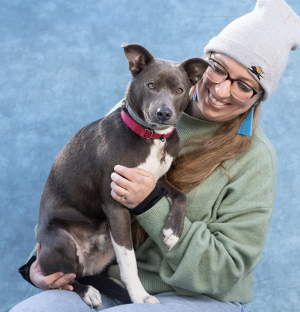
E.B. Bartels
E.B. Bartels is a nonfiction writer, a former Newtonville Booksopens in new tab bookseller, and a GrubStreetopens in new tab instructor, with an MFA from Columbia University. She is the author of Good Grief: On Loving Pets, Here and Hereafteropens in new tab, a narrative nonfiction book about loving and losing animals. E.B. lives in Massachusetts with her husband, Richie, and their many, many pets.
This article was originally published on Slate.com and has been repurposed for Kinship and lightly edited for style.
Related articles
![Curly haired blonde woman hugging her old pug dog]()
How to Care For Your Older Dog
Learn how to make their senior years as comfortable as possible.
![Two senior cats laying on a couch]()
Why Senior Cats Make the Best Roommates
Kitten, please! I adopted a couple of seniors because cats, like wine, only get better with age.
![Senior mixed breed dog playing with washable snuffle rug for hiding dried treats]()
How to Help Your Bored Senior Dog Spice Up Their Life
Spice Girls reference aside, just because your dog is graying around the eyes doesn’t mean those eyes don’t light up at playtime.
![close up of Chihuahua dog's eye with cataracts]()
Common Eye Problems in Dogs and How to Treat Them
Your dog sees you as their best friend, so keep those eyes healthy.
![Dog sitting next to owner]()
DIY Pet Physical Exam: How to Check Your Dog’s Breathing & Skin
Veterinarian Dr. Shea Cox on how to get comfortable checking your dog’s breathing, respiratory rate, and skin hydration.
![Woman with purple hair kissing the face of her chocolate brown hound dog]()
8 Comforting Thoughts to Help You Through the Death of Your Pet
There’s no guidebook to grief and loss — but these kind words will help.

